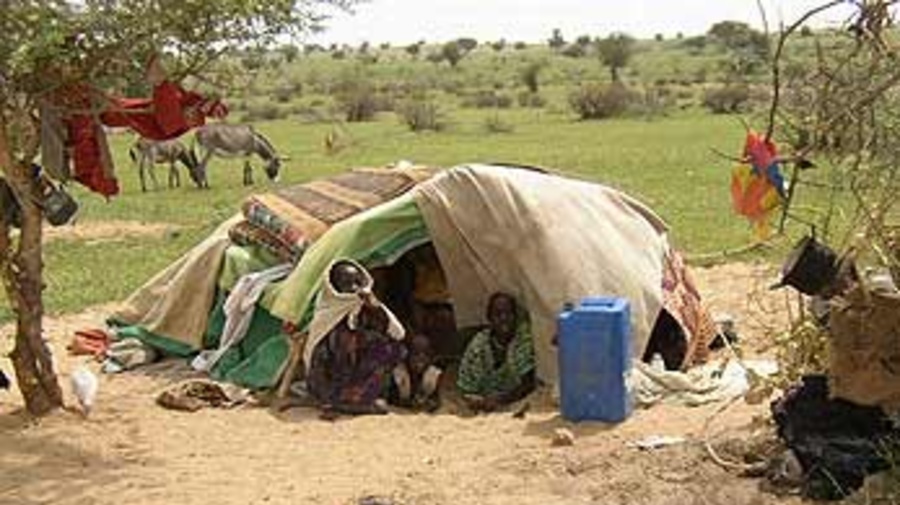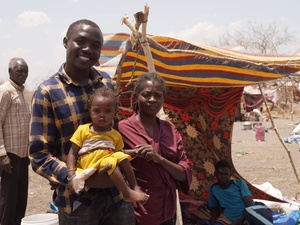UNHCR still working to move refugees from Chad-Sudan border
UNHCR still working to move refugees from Chad-Sudan border

Sudanese refugees in Birak, eastern Chad, where cross-border raids of livestock and other property have been reported.
N'DJAMENA, Chad, Oct 9 (UNHCR) - The UN refugee agency is stepping up efforts to identify suitable locations to transfer more than 65,000 Sudanese refugees living along the Chad-Sudan border amid growing concerns that a ceasefire period on the Sudanese side is ending.
The refugees started fleeing the Darfur region of western Sudan in April when fighting broke out between the Khartoum government and the rebel Sudan Liberation Movement (SLM). A ceasefire deal was reached between the warring factions on September 4 and was supposed to last for 40 days. Both sides have accused the other of breaching the truce.
In eastern Chad, Sudanese refugees who have been keenly monitoring developments in their homeland say that although there have been no air bombardments in their home areas since mid-September, they are still afraid to return to their homes, some of which have been burnt or looted by armed militia.
Since their arrival in eastern Chad, the over-65,000 Sudanese refugees have been living in a series of sites dotted along hundreds of kilometres along the volatile border. As UNHCR's emergency team continued to visit clusters of refugees in several border sites, it received worrying reports about several security incidents in refugee-hosting areas.
In Iriba, west of Tine, local authorities spoke of anti-personnel landmines planted in some areas along the border. The medical non-governmental organisation, MSF-Belgium, confirmed that its staff had treated two children who were injured by land mines in these areas.
In Birak, and in locations close to Adré, several cross-border raids were reported. The UNHCR team was told that refugees with livestock were particularly at risk as raiders were on the lookout for animals, among other property. Chadian authorities have since deployed military personnel to protect the refugees, estimated at some 12,000 to 15,000 people. Many of them are living in sites about 15 km from the border. In discussions with the UNHCR team, some of the refugees said they felt their safety would be improved by increased military presence and not by relocation further inland. They explained that incursions had occurred as far inland as 40 km from the border.
In other reports, UNHCR staff heard that rebels of the SLA (the military wing of the SLM) were present in Tine, a town that straddles the Chad-Sudan border. The rebels were visible in the town where they were said to be shopping for supplies. Tine and surrounding areas have one of the highest refugee concentrations with an estimated 28,000 new refugees. UNHCR has, however, been unable to verify numbers as refugees continue to be mobile and scattered across vast areas, often mixed with the local population.
Poor security in some areas prevented the UNHCR team from reaching some locations. One such location was Bamina, 35 km from Tine, where there are reports of large numbers of refugees. But in Adré, the emergency team travelled to refugee sites with military escort. Refugee sites between Adré and Ade, further south, are in areas that have experienced border incursions and roadblocks mounted by armed groups.
In the meantime, UNHCR has identified a number of locations that could be developed as centres for communal kitchens. The plan is for implementing partners to use the centres to prepare and serve cooked food to vulnerable refugees such as children under five, pregnant women, the sick and the elderly. These centres could also be used for the distribution of basic domestic supplies to groups of refugees. Relief supplies for up to 40,000 people were recently airlifted to eastern Chad from UNHCR's regional stockpile in Ngara, western Tanzania.
As the refugee agency stepped up the search for sites for new camps, its staff visited several locations identified by local authorities to establish up to four camps for the recent refugees. The staff found that some of the proposed sites were still too close to the fragile border. Other proposed sites did not have readily available water resources. Because of recent rains, water supplies are, however, still available in river beds known locally as wadis. However, the water situation is expected to worsen in the coming weeks when the dry spell sets in and the wadis dry up.
Pending relocation to new sites, refugees continue to live under makeshift shelters while others in towns like Tine are being housed by local people. Some refugees, many of them from farming communities, said they continued to rely on assistance from local communities or on casual work in nearby towns or fields.









